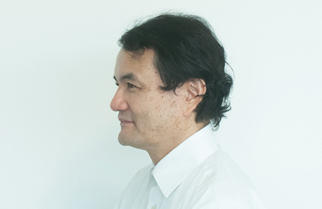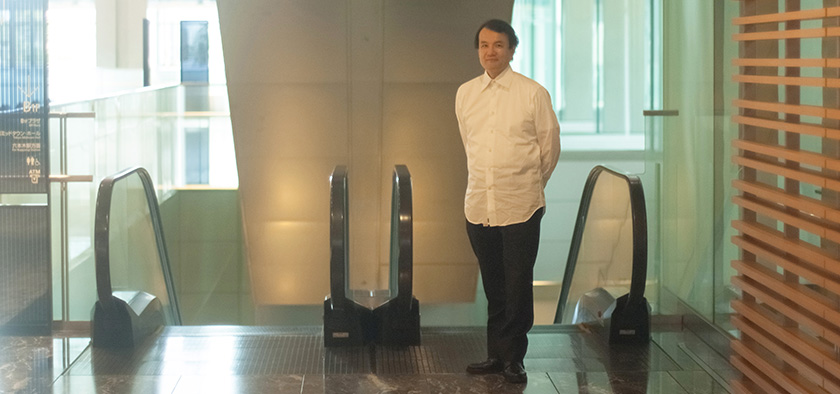
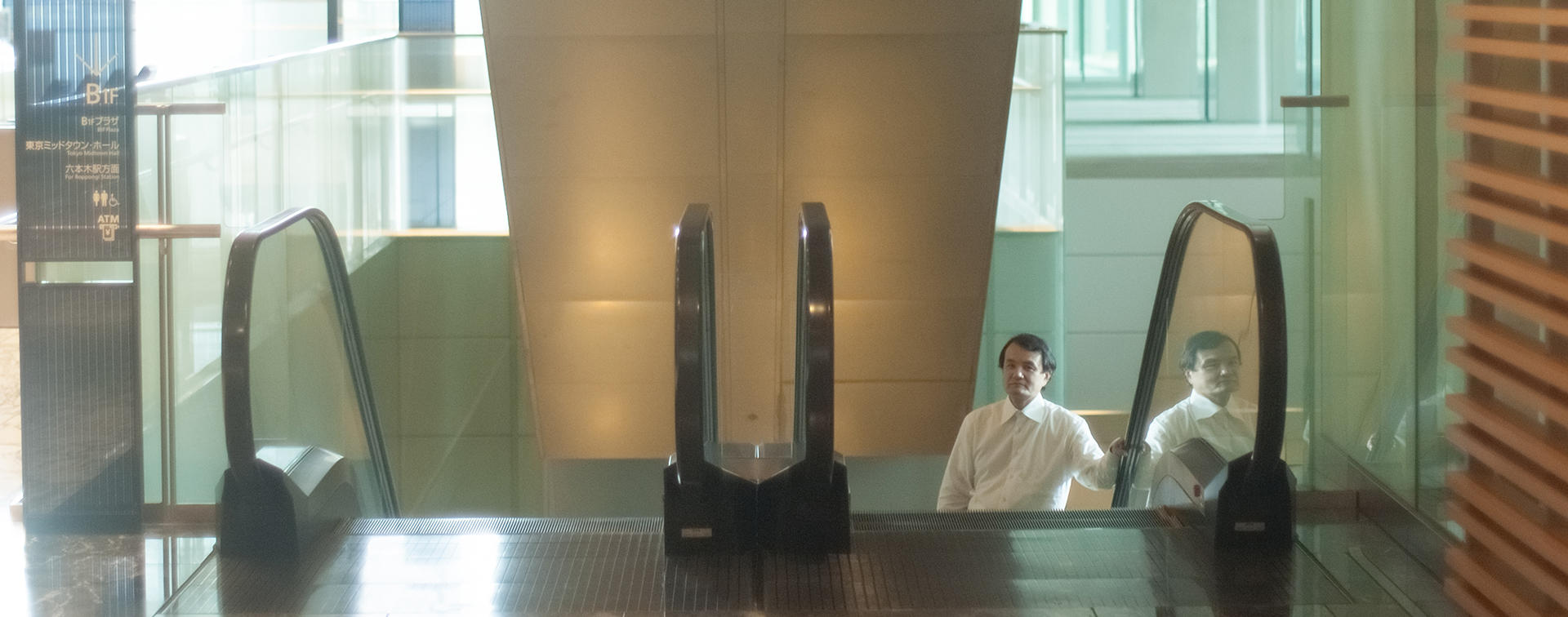

"The new context needed in the streets of Roppongi"
Making connectings with roads, information and history Providing a place for creation
On August 24, the "Midtown Design and Art Live" event was held in the Atrium at Tokyo Midtown. Product designer Shunji Yamanaka, who is also professor at the University of Tokyo, was the guest for the"Roppongi Future Talks" interview held on stage. At the beginning of the interview, Yamanaka glanced at the large audience and said in a friendly manner, "Roppongi lacks context, don't you think?" What did he mean by "context"? Please read on to find out.
"Lack of context" - both the strong point and weak point of Roppongi
In 2009, we did a "Bones" exhibition at 21_21 DESIGN SIGHT. Design is generally thought of as being about colors and shapes and the outward appearance, but good designs can only be made by starting from the inner workings - you have to think about the framework and the structure. The bone structures of animals are truly beautiful. So we held this exhibition to encourage people to think; we displayed the bones of living creatures alongside the "bones" of man-made objects, namely the inner framework of industrial products.
When I was asked to talk about Roppongi for this event, it occurred to me that Roppongi does not have the bone structure. Trying to recall what Roppongi is like, so many aspects of the town came to my mind; it's not a place that can be defined by a few words. I suppose this lack of context is what makes Roppongi appealing, but at the same time, it also seems to be its weak point.
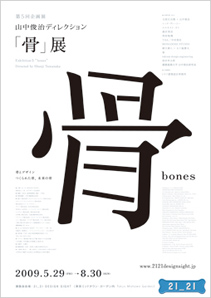
"Bones" Exhibition
An exhibition directed by Shunji Yamanaka which took a look at the relationship between the sophisticated bone structure of living creatures and the forms and functions of industrial products. The keywords of the exhibition were "bones" and "bone structure." Works by 12 pairs of artists were shown, shedding light on "frameworks of the future."
Learning about designs in Roppongi
I began to develop strong ties with Roppongi in the early 1980s when I had just become a designer. It was around that time that AXIS was built, and the (AXIS) magazine was published, and design-related companies and art galleries became tenants of the building. A bit further away, in Nogizaka on the other side, there were art galleries such as Toto Gallery Ma. For me, Roppongi was an area where I could learn all kinds of things about design.
AXIS
A company that began design-related operations in 1981. It publishes the magazine "AXIS" and is engaged in a wide range of businesses. The AXIS building in Iikura Katamachi houses the AXIS Gallery, "LIVING MOTIF", the company's directly-owned lifestyle shop, as well as restaurants, an art studio space and a bookshop.
When I left the company I was working for and became an independent designer, I had an office in Minami-Azabu for many years. I also lived in Roppongi-itchome for a while in a place near the Hotel Okura. The room had a view of the Tokyo Tower right in front, and I liked the place. Then one day, I was curious to know how my place looked from the Tokyo Tower, and so I went up to the observation deck and looked through a telescope. And I could see everything so clearly - like people eating their meals, and I thought, I mustn't open the curtains any more. (laughs) That wasn't the direct reason, but I began to feel that it wasn't a comfortable place to live, and I moved out less than a year later.
Disappearance of the "wonderlands"
When I was still a student, there used to be the University of Tokyo's Institute of Industrial Science in Roppongi which I sometimes used to visit. In the area around Roppongi-Rokuchome where the Roppongi Hills now stands, there were intriguing neighborhoods where tiny houses were clustered together. These places were like "wonderlands" but they have steadily disappeared and there are now standard commercial facilities standing in their place. Today, Roppongi offers an array of things, but once people get here and see what they intended to see, they go home and that's it. It has become a town which you just visit.
I don't know if that is a bad thing; there must be people who think it's a good thing. I myself am not an expert of city living. If asked if I like Roppongi, I'm the type who would say, "Not particularly." (laughs) I know the daytime face of Roppongi very well but as for the nighttime face, I only vaguely imagine it as being a drinking town. And there are still strange areas in the gaps between the commercial facilities.

The huge commercial facilities are unconnected
Roppongi is currently promoting itself as an area of design and art, but contrary to expectations, its history is young. In the Edo period, this area was the location of samurai residences. After World War II, U.S. military facilities and the U.S. embassy were built. That led to many foreigners living here, and eating and drinking establishments sprung up to cater for them. The TV Asahi is headquartered here, so Roppongi also has a strong image of being a town of show business people.
And then the developers began making commercial facilities with "design" and "art" as the keywords, and the image of the area was transformed. But I think it was a very abrupt kind of transformation. Maybe this is a fundamental problem that underlies town development in Japan, but it seems to me that there has been no vision for what should be done about the landscape of the town as a whole.
The commercial facilities contain parks and art museums, and each of them is like a town. But these huge facilities are scattered here and there without being connected to each other. That's probably one of the reasons why I feel Roppongi lacks context.
Visitors to Roppongi go to only one facility?
When we held the "Bones" exhibition, I noticed that it was not easy for visitors to go back and forth between facilities. For example, there was no pedestrian crossing which people could use to go straight from Tokyo Midtown to the National Art Center, Tokyo. So people were crossing over to the other side from all kinds of places where there were no traffic lights and it was really dangerous. This situation was recently remedied at long last.

The National Art Center, Tokyo
Opened in January 2007 on the former site of the University of Tokyo's Institute of Industrial Science. It is the sole Japanese national museum that does not have its own collection. Many varied exhibitions are held in its halls which are the largest exhibition spaces in Japan. The museum building was designed by architect Kisho Kurokawa. The museum's logo is by Kashiwa Sato.
Ark Hills, Roppongi Hills and Tokyo Midtown - Roppongi has three massive commercial facilities that have art museums and residences, and yet there are few people who go to more than one facility on the same day. The reason is that all of the facilities are similar, so if you go to one, that's enough. There are also many art museums, but I think the average person from outside Roppongi asks himself, "Which event shall I go to?" and then visits just one museum.
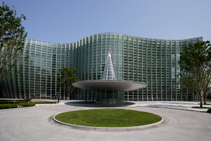
Ark Hills
A multipurpose complex straddling Akasaka-itchome and Roppongi-itchome. Completed in 1986, it was Japan's first large-scale redevelopment project in the private sector. Comprising offices, residences, a hotel and a concert hall, it is known as the first "Hills" building by the developer Mori Building.
The facilities advocating design and art have been built in a haphazard way and are not linked to each other. That's why this town has become an area where you just pick one facility to visit and that's the end of it. It would be better if the facilities had more distinct personalities and if it were more obvious to people what kind of things they could expect to see at each facility. Then people would have a sense of purpose and think, "We better go to that facility today." and get the urge to visit maybe two or three facilities in a row. They would then be able to gain a slightly deeper experience of Roppongi instead of being satisfied with having fun in just one place.
Connecting with roads, information, history
In Europe, there are towns which ban cars, and connect the facilities by letting people get there by bicycle. This is a physical way of connection which is very easy to understand. Another way to connect is to provide information on the facilities. For instance, information could be provided to Tokyo Midtown visitors on the events going on at National Art Center, Tokyo and Roppongi Hills. Or perhaps a system could be set up where people can see what is going in the residential areas and small shops that lie between the facilities.
Another thing is that the context of a town is created by history. Areas which used to be the sites for temples or castles always have something which echoes their past; such towns have an appeal that has been passed on over the years and that lingers on in the present. In Roppongi though, I don't see much of this.
My wife went to a girls' school in Roppongi, and she often tells me about what this area used to be like. I've heard that from the fourth floor of the school building, you could see the sea. Thankfully, the building of that girls' school has been renovated in a way that retains its original appearance. Beside Tokyo Midtown there is an old park called Hinokicho Park; its original appearance has been preserved. If you are thinking of having a big vision that spans the next 50 years or next 100 years, it would be a good idea to develop the town once more, and make streets that have historical context.
Roads, information or history. Any of these can be used to make connections and create new contexts. I'm sure this would lead to discoveries and a better appreciation of the town.

The heritage of an international atmosphere
I said that Roppongi lacks context, but one thing that has been passed on is the image of a very innovative culture. To be more precise, the town has an international atmosphere. If you are searching for nice furniture and interior goods designed overseas, you can easily find what you are looking for by wandering around these streets. And you can buy foreign books here too. The art museums show not only classical works, but also hold events related to contemporary art and design. I think it's a really good town for getting the latest trend.
When you think about it, Roppongi is a town with a peculiar historical background. First there were the samurai residences, and then after the war, the U.S. military and many foreigners came, and the town's international image was created. In the beginning it was mostly a night town, but that gradually changed. That has been the driving force of the town, and it is the context which has shaped Roppongi into what it is today.
No shops for procuring tools and materials
On a personal level, I've held many exhibitions in Roppongi. I frequently show my creations here because I think Roppongi gathers people who are interested in art and design, and it's a place that has the power to draw customers.
From the perspective of creators though, Roppongi is both convenient and inconvenient. One of the reasons that it is inconvenient is that it's not easy to procure tools and materials here. This is about my wife again, but my wife belonged to a drama club in high school and when it was time to make the props, they had to walk to a large timber store in Tameike to get hold of what they needed. Today, if you are holding an exhibition or announcing your new artwork in Roppongi, and you want to buy materials or do some processing treatment, you have to go all the way to Shibuya or thereabouts. It's strange that so many design offices have been in Roppongi for so long and yet there are no places to make things. It's a pity, considering the numerous places that are available for showing works.
Making a place for creation in Tokyo Midtown
When making something, it used to be normal for the place of manufacture to be within a factory - a large-scale production facility. But circumstances have changed dramatically. Collaborating with Paralympic athletes, I'm currently designing prosthetic hands and feet; in the past it used to take several weeks to make a mold, but now it can be done in one night using a 3D printer.
With the advent of the Internet, small shops that make things can now be linked to the world. They can advertise and directly sell their products. A shop can do business all on its own. Independent creators are now regaining attention for their handcrafts and this is largely due to the change in our environment. It's as if a new context has come about in the area of making things.
I think that in the future, a commercial facility might have not only museums, shops and residences, but also a place for creation. It could be a workspace like the Fab Lab whose network is currently spreading in Japan, where you can use all kinds of machinery tools and devices such as 3D printers. Or it could be a small shop where artisans make things on the spot and sell them. It would probably be difficult to immediately set up a permanent place, so it might be a good idea to start by providing such spaces in events. It would be fascinating if we could make such a place for creation in Tokyo Midtown.
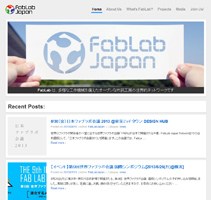
Fab Lab
A grassroots network of experimental laboratories/workshops based in more than 20 countries. In Japan, there are Fab Labs in six places such as Kamakura, Tsukuba, and Shibuya. The laboratories are equipped with a variety of machine tools, both digital and analog, including 3D printers and cutting machines.
Editor's thoughts
Yamanaka-san started teaching in April this year at the Institute of Industrial Science, University of Tokyo, which used to be located in Roppongi. Listening to him talk about the Edo period and about the vision for the next 50 to 100 years, I felt as if I were taking a lecture on Roppongi's past and future. I was surprised to learn that it used to be possible to get a view of the sea in Roppongi.(edit_kentaro inoue)




